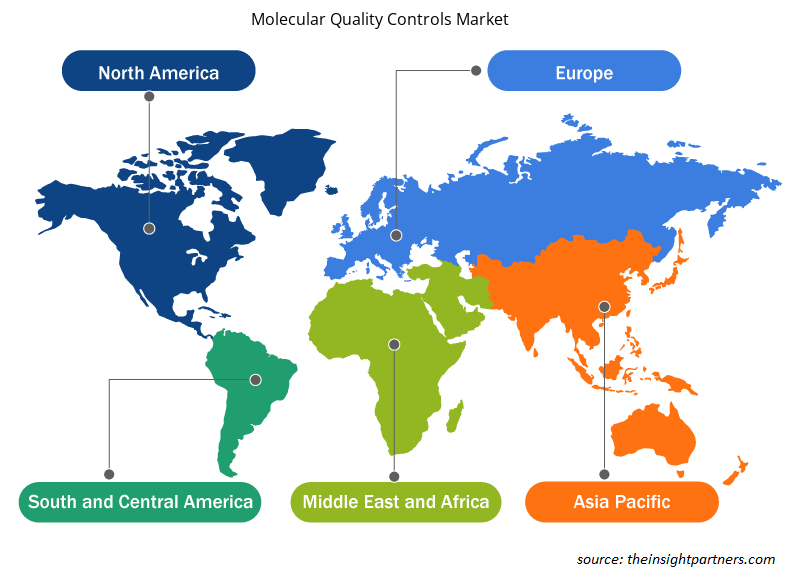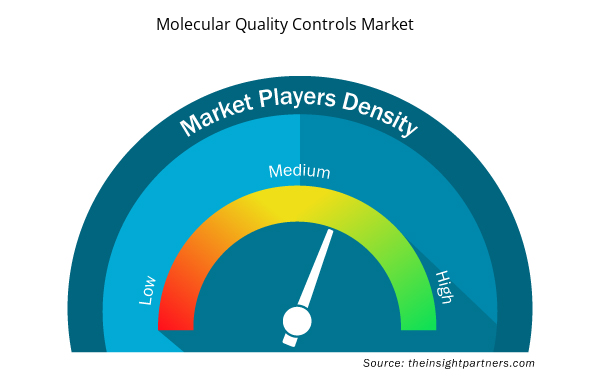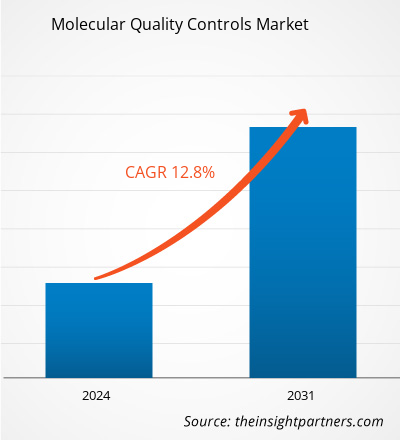من المتوقع أن يصل حجم سوق ضوابط الجودة الجزيئية إلى 0.52 مليار دولار أمريكي بحلول عام 2031 من 0.22 مليار دولار أمريكي في عام 2023. ومن المتوقع أن يسجل السوق معدل نمو سنوي مركب بنسبة 12.8٪ خلال الفترة 2023-2031. ومن المرجح أن يظل الطلب المتزايد على الأدوية المخصصة اتجاهًا رئيسيًا في السوق.
تحليل سوق ضوابط الجودة الجزيئية
إن عوامل مثل زيادة الأموال المخصصة لعلم الجينوم وزيادة انتشار الأمراض الوراثية تعمل على تغذية نمو السوق. وعلاوة على ذلك، فإن التركيز المتزايد على التشخيص الجزيئي يشكل فرصة رئيسية للاعبين في سوق مراقبة الجودة الجزيئية.
نظرة عامة على سوق ضوابط الجودة الجزيئية
كان تسلسل الجينوم مقتصرًا على مرافق البحث قبل بضع سنوات. ومع ذلك، فقد أصبح الآن أحد التقنيات القياسية في الممارسات السريرية. وفقًا للدراسة "دمج الجينوم في الرعاية الصحية"، من المتوقع أن ينتج قطاع الرعاية الصحية على مدار السنوات القليلة القادمة بيانات جينومية لأكثر من 60 مليون مريض. يتم دعم التنفيذ المتزايد لتسلسل الجينوم في أنظمة الرعاية الصحية من خلال استثمارات حكومية كبيرة، يبلغ مجموعها أكثر من 4 مليارات دولار أمريكي في 14 دولة على الأقل. أعلنت المملكة المتحدة عن أكبر مشروع جينوم في العالم كجزء من تعاون بين القطاعين العام والخاص بقيمة 200 مليون دولار بين المنظمات الخيرية وشركات الأدوية .
قم بتخصيص هذا التقرير ليناسب متطلباتك
ستحصل على تخصيص لأي تقرير - مجانًا - بما في ذلك أجزاء من هذا التقرير، أو تحليل على مستوى الدولة، وحزمة بيانات Excel، بالإضافة إلى الاستفادة من العروض والخصومات الرائعة للشركات الناشئة والجامعات
- احصل على أهم اتجاهات السوق الرئيسية لهذا التقرير.ستتضمن هذه العينة المجانية تحليلاً للبيانات، بدءًا من اتجاهات السوق وحتى التقديرات والتوقعات.
محركات وفرص سوق ضوابط الجودة الجزيئية
تزايد انتشار الأمراض الوراثية
نظرًا لأن ضوابط الجودة الجزيئية تسهل تفسير النتائج، فإنها تُستخدم في الكشف عن الاضطرابات الوراثية. إن النسخة الكاملة أو الجزئية الإضافية من الكروموسوم 21 هي الانقسام الخلوي الشاذ الناتج الذي ينتج المرض الوراثي المعروف باسم متلازمة داون. وفقًا لمراكز السيطرة على الأمراض والوقاية منها في الولايات المتحدة، يولد حوالي 6000 طفل في الولايات المتحدة مصابين بمتلازمة داون كل عام. نتيجة لذلك، تزداد الاختبارات قبل الولادة لمتلازمة داون على مستوى البلاد.
يحدث تحور في جينين، BRCA1 (جين سرطان الثدي الأول) وBRCA2 (جين سرطان الثدي الثاني)، في أغلب حالات سرطان الثدي الوراثية. ووفقًا للجمعية الأمريكية للسرطان، فإن الجينات المعيبة التي تنتقل من الآباء إلى الأبناء تشكل ما بين 5% إلى 10% من حالات سرطان الثدي الوراثية. ويزداد انتشار الاختبارات الجينية للكشف عن سرطان الثدي الوراثي مع تزايد الوعي بسرطان الثدي.
ارتفاع في اعتماد التشخيص الجزيئي
تُستخدم مناهج التشخيص الجزيئي للكشف عن الاضطرابات بين تسلسلات محددة في الحمض النووي أو الحمض النووي الريبي. تؤدي المخالفات مثل تعدد أشكال النوكليوتيدات المفردة (SNP) والحذف وإعادة الترتيب والإدراج إلى أمراض مختلفة - مثل الأمراض المعدية والسرطان والأمراض الفيروسية والأمراض المنقولة جنسياً (STDs).polymorphism (SNP), deletions, rearrangements, and insertions lead to various diseases—such as infectious diseases, cancer, viral diseases, and sexually transmitted diseases (STDs).
وفقًا لتقرير حقائق وإحصائيات الإنفلونزا، خلال عامي 2017 و2018، كان هناك حوالي 31.4 مليون زيارة للمرضى الخارجيين بسبب الإنفلونزا. وذكر أيضًا أن 5-20٪ من سكان الولايات المتحدة يصابون بالإنفلونزا كل عام. وعلاوة على ذلك، وفقًا للمعهد الوطني للسرطان، في عام 2020، سيتم تشخيص حوالي 1،806،590 حالة إصابة جديدة بالسرطان في الولايات المتحدة، مع تقدير عدد الوفيات بنحو 606،520. ومن المتوقع أن يرتفع عدد الأشخاص المصابين بالسرطان إلى 19 مليونًا بحلول عام 2024. يؤدي هذا الانتشار المرتفع للأمراض المعدية وزيادة حالات الإصابة بالسرطان إلى زيادة الجذب نحو التشخيص الجزيئي، لأنه قادر على تشخيص الأمراض بدقة عالية، مما يمهد الطريق لعلاج المرضى بالطب الدقيق.
تقرير تحليل تجزئة سوق ضوابط الجودة الجزيئية
إن القطاعات الرئيسية التي ساهمت في استخلاص تحليل سوق ضوابط الجودة الجزيئية هي المنتج والتطبيق والمستخدم النهائي.
- بناءً على المنتج، يتم تقسيم سوق ضوابط الجودة الجزيئية إلى ضوابط مستقلة وضوابط خاصة بالأجهزة؛ نوع المحلل (ضوابط محلل واحد وضوابط محلل متعدد). احتل قطاع الضوابط المستقلة حصة سوقية كبيرة في عام 2023.analyte type (single analyte controls and multi analyte controls). The independent controls segment held a most significant market share in 2023.
- بناءً على التطبيق، يتم تقسيم سوق ضوابط الجودة الجزيئية حسب الأمراض المعدية والأورام والاختبارات الجينية والتطبيقات الأخرى. احتل قطاع الأمراض المعدية الحصة الأكبر في السوق في عام 2023.
- بناءً على المستخدمين النهائيين، يتم تقسيم سوق ضوابط الجودة الجزيئية حسب المختبرات السريرية والمستشفيات ومصنعي التشخيص المخبري ومنظمات البحث التعاقدية والمعاهد الأكاديمية والبحثية والمستخدمين النهائيين الآخرين. احتل قطاع المختبرات السريرية أكبر حصة في السوق في عام 2023.ivd manufacturers & contract research organizations, academic & research institutes, other end users. The clinical laboratories segment held a largest market share in 2023.
تحليل حصة سوق ضوابط الجودة الجزيئية حسب المنطقة الجغرافية
ينقسم النطاق الجغرافي لتقرير سوق ضوابط الجودة الجزيئية بشكل أساسي إلى خمس مناطق: أمريكا الشمالية، ومنطقة آسيا والمحيط الهادئ، وأوروبا، والشرق الأوسط وأفريقيا، وأمريكا الجنوبية والوسطى.
في أمريكا الشمالية، تعد الولايات المتحدة السوق الأكثر أهمية في مجال مراقبة الجودة الجزيئية. ومن بين العوامل الرئيسية الدافعة لهذا النمو الاستثمارات المتزايدة والأموال المتنامية المخصصة لشركات التصنيع وكذلك المعاهد الأكاديمية والبحثية لتطوير أدوية السرطان، وتزايد عدد كبار السن، والأمراض المعدية، وغير ذلك من العلاجات.
من المتوقع عمومًا أن تساعد التشخيصات القائمة على التسلسل التسلسلي للجيل التالي في توجيه اختيار الرعاية في المستقبل لتحسين نتائج المرضى. ووفقًا للمعهد الوطني للسرطان، في الولايات المتحدة، من المتوقع تشخيص ما يقرب من 1,806,590 حالة جديدة من السرطان في عام 2020، مع وفاة 606,520 شخصًا بسبب المرض. وبالمثل، وفقًا لجمعية اللوكيميا والليمفوما (LLS)، تم تشخيص ما يقرب من 178,520 شخصًا في الولايات المتحدة بسرطان الدم أو الليمفوما أو النخاع العظمي في عام 2020. ونتيجة لذلك، فإن العوامل المذكورة أعلاه من شأنها أن تعزز نمو السوق في الأطر الزمنية المتوقعة.
رؤى إقليمية حول سوق ضوابط الجودة الجزيئية
لقد قام المحللون في Insight Partners بشرح الاتجاهات والعوامل الإقليمية المؤثرة على سوق ضوابط الجودة الجزيئية طوال فترة التوقعات بشكل شامل. يناقش هذا القسم أيضًا قطاعات سوق ضوابط الجودة الجزيئية والجغرافيا في جميع أنحاء أمريكا الشمالية وأوروبا ومنطقة آسيا والمحيط الهادئ والشرق الأوسط وأفريقيا وأمريكا الجنوبية والوسطى.

- احصل على البيانات الإقليمية المحددة لسوق ضوابط الجودة الجزيئية
نطاق تقرير سوق ضوابط الجودة الجزيئية
| سمة التقرير | تفاصيل |
|---|---|
| حجم السوق في عام 2023 | 0.22 مليار دولار أمريكي |
| حجم السوق بحلول عام 2031 | 0.52 مليار دولار أمريكي |
| معدل النمو السنوي المركب العالمي (2023 - 2031) | 12.8% |
| البيانات التاريخية | 2021-2022 |
| فترة التنبؤ | 2024-2031 |
| القطاعات المغطاة | حسب المنتج
|
| المناطق والدول المغطاة | أمريكا الشمالية
|
| قادة السوق وملفات تعريف الشركات الرئيسية |
|
كثافة اللاعبين في سوق ضوابط الجودة الجزيئية: فهم تأثيرها على ديناميكيات الأعمال
يشهد سوق ضوابط الجودة الجزيئية نموًا سريعًا، مدفوعًا بالطلب المتزايد من المستخدم النهائي بسبب عوامل مثل تفضيلات المستهلك المتطورة والتقدم التكنولوجي والوعي المتزايد بفوائد المنتج. ومع ارتفاع الطلب، تعمل الشركات على توسيع عروضها والابتكار لتلبية احتياجات المستهلكين والاستفادة من الاتجاهات الناشئة، مما يؤدي إلى زيادة نمو السوق.
تشير كثافة اللاعبين في السوق إلى توزيع الشركات أو المؤسسات العاملة في سوق أو صناعة معينة. وهي تشير إلى عدد المنافسين (اللاعبين في السوق) الموجودين في مساحة سوق معينة نسبة إلى حجمها أو قيمتها السوقية الإجمالية.
الشركات الرئيسية العاملة في سوق مراقبة الجودة الجزيئية هي:
- شركة ثيرمو فيشر العلمية المحدودة
- كنوستيكس
- مختبرات بيو-راد، المحدودة
- شركة ف. هوفمان لاروش المحدودة.
- أبوت، شركة كويدل
- شركة ماين للتحكم الجزيئي
إخلاء المسؤولية : الشركات المذكورة أعلاه ليست مرتبة بأي ترتيب معين.

- احصل على نظرة عامة على أهم اللاعبين الرئيسيين في سوق ضوابط الجودة الجزيئية
أخبار سوق ضوابط الجودة الجزيئية والتطورات الأخيرة
يتم تقييم سوق ضوابط الجودة الجزيئية من خلال جمع البيانات النوعية والكمية بعد البحث الأولي والثانوي، والتي تتضمن منشورات الشركات المهمة وبيانات الجمعيات وقواعد البيانات. فيما يلي بعض التطورات في سوق ضوابط الجودة الجزيئية:
- أبرمت شركة Abbott وشركة Personalis, Inc. اتفاقية تعاون لتطوير وتوزيع أدوات التحكم في الخزعة السائلة المخصصة للاستخدام في أبحاث التسلسل الجيني للجيل التالي (NGS). والهدف من هذا التعاون هو تعزيز دقة وموثوقية إجراءات الخزعة السائلة للكشف عن السرطان وتتبعه. (المصدر: موقع شركة Abbott على الويب، مايو 2024)
- وفقًا لشركة Qiagen، أصبحت أدوات التحكم الجديدة في الحمل الفيروسي QuantiTect لفيروس تضخم الخلايا وفيروس التهاب الكبد B وفيروس SARS-CoV-2 متاحة الآن. وتلبي هذه الأدوات المتطلبات المتزايدة لمراقبة العدوى الفيروسية بدقة في البيئات السريرية. (المصدر: موقع شركة Qiagen على الويب، يناير 2024)
تغطية تقرير سوق ضوابط الجودة الجزيئية والمنتجات النهائية
يوفر تقرير "حجم سوق ضوابط الجودة الجزيئية والتوقعات (2021-2031)" تحليلاً مفصلاً للسوق يغطي المجالات التالية:
- حجم السوق وتوقعات ضوابط الجودة الجزيئية على المستويات العالمية والإقليمية والوطنية لجميع قطاعات السوق الرئيسية التي يغطيها النطاق
- تتحكم جودة الجزيئات في اتجاهات السوق بالإضافة إلى ديناميكيات السوق مثل المحركات والقيود والفرص الرئيسية
- تحليل مفصل لقوى PEST/Porter الخمس وSWOT
- تحليل سوق ضوابط الجودة الجزيئية يغطي اتجاهات السوق الرئيسية والإطار العالمي والإقليمي واللاعبين الرئيسيين واللوائح والتطورات الأخيرة في السوق.
- تحليل المشهد الصناعي والمنافسة الذي يغطي تركيز السوق، وتحليل خريطة الحرارة، واللاعبين البارزين، والتطورات الأخيرة لسوق ضوابط الجودة الجزيئية
- ملفات تعريف الشركة التفصيلية
- التحليل التاريخي (سنتان)، السنة الأساسية، التوقعات (7 سنوات) مع معدل النمو السنوي المركب
- تحليل PEST و SWOT
- حجم السوق والقيمة / الحجم - عالميًا وإقليميًا وقطريًا
- الصناعة والمنافسة
- مجموعة بيانات Excel


- Educational Furniture Market
- Energy Recovery Ventilator Market
- Dropshipping Market
- Single-Use Negative Pressure Wound Therapy Devices Market
- Smart Mining Market
- Customer Care BPO Market
- Architecture Software Market
- Grant Management Software Market
- Enteral Nutrition Market
- Intraoperative Neuromonitoring Market

Report Coverage
Revenue forecast, Company Analysis, Industry landscape, Growth factors, and Trends

Segment Covered
This text is related
to segments covered.

Regional Scope
North America, Europe, Asia Pacific, Middle East & Africa, South & Central America

Country Scope
This text is related
to country scope.
الأسئلة الشائعة
North America dominated the molecular quality controls market in 2023
Factors such as growing funds for genomics, declining cost of sequencing procedures, and increasing prevalence of genetic diseases fuel the growth of the market. However, the dearth of skilled professionals hinders the market growth.
The burgeoning demand for personalized Medicine will likely remain a key trend in the market.
THERMO FISHER SCIENTIFIC, INC., Qnostics, BIO-RAD LABORATORIES, INC., F. HOFFMANN LA-ROCHE LTD., Abbott, Quidel Corporation, Maine Molecular Controls, Inc., Zeptometrix Corporation, Microbiologics, and Seracare Life Sciences.
The market is expected to register a CAGR of 12.8% during 2023–2031.
Trends and growth analysis reports related to Life Sciences : READ MORE..
The Insight Partners performs research in 4 major stages: Data Collection & Secondary Research, Primary Research, Data Analysis and Data Triangulation & Final Review.
- Data Collection and Secondary Research:
As a market research and consulting firm operating from a decade, we have published and advised several client across the globe. First step for any study will start with an assessment of currently available data and insights from existing reports. Further, historical and current market information is collected from Investor Presentations, Annual Reports, SEC Filings, etc., and other information related to company’s performance and market positioning are gathered from Paid Databases (Factiva, Hoovers, and Reuters) and various other publications available in public domain.
Several associations trade associates, technical forums, institutes, societies and organization are accessed to gain technical as well as market related insights through their publications such as research papers, blogs and press releases related to the studies are referred to get cues about the market. Further, white papers, journals, magazines, and other news articles published in last 3 years are scrutinized and analyzed to understand the current market trends.
- Primary Research:
The primarily interview analysis comprise of data obtained from industry participants interview and answers to survey questions gathered by in-house primary team.
For primary research, interviews are conducted with industry experts/CEOs/Marketing Managers/VPs/Subject Matter Experts from both demand and supply side to get a 360-degree view of the market. The primary team conducts several interviews based on the complexity of the markets to understand the various market trends and dynamics which makes research more credible and precise.
A typical research interview fulfils the following functions:
- Provides first-hand information on the market size, market trends, growth trends, competitive landscape, and outlook
- Validates and strengthens in-house secondary research findings
- Develops the analysis team’s expertise and market understanding
Primary research involves email interactions and telephone interviews for each market, category, segment, and sub-segment across geographies. The participants who typically take part in such a process include, but are not limited to:
- Industry participants: VPs, business development managers, market intelligence managers and national sales managers
- Outside experts: Valuation experts, research analysts and key opinion leaders specializing in the electronics and semiconductor industry.
Below is the breakup of our primary respondents by company, designation, and region:

Once we receive the confirmation from primary research sources or primary respondents, we finalize the base year market estimation and forecast the data as per the macroeconomic and microeconomic factors assessed during data collection.
- Data Analysis:
Once data is validated through both secondary as well as primary respondents, we finalize the market estimations by hypothesis formulation and factor analysis at regional and country level.
- Macro-Economic Factor Analysis:
We analyse macroeconomic indicators such the gross domestic product (GDP), increase in the demand for goods and services across industries, technological advancement, regional economic growth, governmental policies, the influence of COVID-19, PEST analysis, and other aspects. This analysis aids in setting benchmarks for various nations/regions and approximating market splits. Additionally, the general trend of the aforementioned components aid in determining the market's development possibilities.
- Country Level Data:
Various factors that are especially aligned to the country are taken into account to determine the market size for a certain area and country, including the presence of vendors, such as headquarters and offices, the country's GDP, demand patterns, and industry growth. To comprehend the market dynamics for the nation, a number of growth variables, inhibitors, application areas, and current market trends are researched. The aforementioned elements aid in determining the country's overall market's growth potential.
- Company Profile:
The “Table of Contents” is formulated by listing and analyzing more than 25 - 30 companies operating in the market ecosystem across geographies. However, we profile only 10 companies as a standard practice in our syndicate reports. These 10 companies comprise leading, emerging, and regional players. Nonetheless, our analysis is not restricted to the 10 listed companies, we also analyze other companies present in the market to develop a holistic view and understand the prevailing trends. The “Company Profiles” section in the report covers key facts, business description, products & services, financial information, SWOT analysis, and key developments. The financial information presented is extracted from the annual reports and official documents of the publicly listed companies. Upon collecting the information for the sections of respective companies, we verify them via various primary sources and then compile the data in respective company profiles. The company level information helps us in deriving the base number as well as in forecasting the market size.
- Developing Base Number:
Aggregation of sales statistics (2020-2022) and macro-economic factor, and other secondary and primary research insights are utilized to arrive at base number and related market shares for 2022. The data gaps are identified in this step and relevant market data is analyzed, collected from paid primary interviews or databases. On finalizing the base year market size, forecasts are developed on the basis of macro-economic, industry and market growth factors and company level analysis.
- Data Triangulation and Final Review:
The market findings and base year market size calculations are validated from supply as well as demand side. Demand side validations are based on macro-economic factor analysis and benchmarks for respective regions and countries. In case of supply side validations, revenues of major companies are estimated (in case not available) based on industry benchmark, approximate number of employees, product portfolio, and primary interviews revenues are gathered. Further revenue from target product/service segment is assessed to avoid overshooting of market statistics. In case of heavy deviations between supply and demand side values, all thes steps are repeated to achieve synchronization.
We follow an iterative model, wherein we share our research findings with Subject Matter Experts (SME’s) and Key Opinion Leaders (KOLs) until consensus view of the market is not formulated – this model negates any drastic deviation in the opinions of experts. Only validated and universally acceptable research findings are quoted in our reports.
We have important check points that we use to validate our research findings – which we call – data triangulation, where we validate the information, we generate from secondary sources with primary interviews and then we re-validate with our internal data bases and Subject matter experts. This comprehensive model enables us to deliver high quality, reliable data in shortest possible time.


 احصل على عينة مجانية لهذا التقرير
احصل على عينة مجانية لهذا التقرير